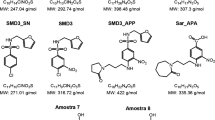Abstract
We showed previously that the disulfonic stilbene DNDS (4, 4′-dinitrostilben-2, 2′-disulfonic acid) was a potent blocker of outwardly rectifying chloride channels (ORCC). The studies reported here were designed to quantify the relationship between electron withdrawal by the 4, 4′-substituents and blocker potency. Specifically we compared the blocking effects and molecular properties of the symmetrically substituted 4, 4′-diaminostilben-2, 2′-disulfonic acid (DADS) and the hemi-substituted 4-amino, 4′-nitrostilben-2, 2′-disulfonic acid (ANDS) with those of DNDS. Blockade was studied using outwardly rectifying colonic chloride channels incorporated into planar lipid bilayers. DADS was 430-fold and ANDS 44-fold less potent than DNDS as blockers of ORCC. Amplitude distribution analysis revealed that all three disulfonic stilbenes act as open channel blockers. Furthermore, this kinetic analysis indicated that the lower potency of DADS and ANDS was due to an increase in off rate. These results support the conclusion that the 4, 4′-substituents make an important contribution to blockade by stabilizing the channel-blocker complex. Isopotential electron contour maps illustrated the dramatic shift in charge at the 4, 4′-poles of the disulfonic stilbene molecule from electronegative in DNDS to electropositive in DADS as well as the bipolar contour of ANDS. Thus, the greater potency of DNDS results from the symmetric electronegative regions at the 4, 4′-poles of the molecule. We hypothesize that the channel protein has two corresponding electropositive areas at the blocker binding site.
Similar content being viewed by others
References
Bridges RJ, Worrell RT, Frizzell RA, Benos DJ: Stibeno disuitonate blockade of colonic secretory Cl− channels in planar lipid bilayers. Am J Physiol 256 (Cell Physiol 25): C902-C912, 1989
Singh AK, Afink GB, Venglarik CJ, Wang R, Bridges RJ: Colonic Cl channel blockade by three classes of compounds. Am J Physiol 260 (Cell Physiol 29): C51-C63, 1991
Singh AK, Venglarik CJ, Bridges RJ: Development and use of chloride channel blockers. Kidney Int: 1994 (in press)
Barzilay M, Ship S, Cabantchik ZI: Anion transport in red blood cells I. Chemical properties as revealed by structure-activity relationships of aromatic sulfonic acids. Mem Biochem 2(2): 227–254, 1979
Barzilay M, Cabantchik ZI: Anion transport in red blood cells II. Kinetics or reversible inhibition by nitroaromatic sulfonic acids. Mem Biochem 2(2): 255–280, 1979
Reinhardt R, Bridges RJ, Rummel W, Lindemann B: Properties of an anion-selective channel from rat colonic enterocyte plasma membranes reconstituted into planar phospholipid bilayers. J Memb Biol 95: 47–54, 1987
Venglarik CJ, Singh AK, Wang R, Bridges RJ: Trinitrophenyl-ATP blocks colonic Cl− channels in planar phospholipid bilayers: evidence for two nucleotide binding sites. J Gen Physiol 101: 545–569, 1993
FitzHugh R: Statistical properties of the asymmetric random telegraph signal, with applications to single-channel analysis. Math Bioser 64: 75–89, 1983
Yellen G: Ionic permeation and blockade in Ca2+-activated K+ channels of bovine chromaffin cells. J Gen Physiol 84: 157–186, 1984
Winegar BD, Landsman JB: Voltage-dependent block by zinc of single calcium channels in mouse myotubes. J Gen Physiol 425: 563–578, 1990
Dewar MS, Zoebisch EG, Healy EF, Stewart JP: AM1: a new general purpose quantum mechanical molecular model. J Am Chem Soc 107: 3902–3909, 1985
Quayle JM, Standen NB, Stanfield PR: The voltage-dependent block of ATP-sensitive potassium channels of frog skeletal muscle by caestum and barium ions. J Physiol 405: 677–697, 1988
Author information
Authors and Affiliations
Rights and permissions
About this article
Cite this article
Venglarik, C.J., Singh, A.K. & Bridges, R.J. Comparison of-nitro versus-amino 4, 4′-substituents of disulfonic stilbenes as chloride channel blockers. Mol Cell Biochem 140, 137–146 (1994). https://doi.org/10.1007/BF00926752
Issue Date:
DOI: https://doi.org/10.1007/BF00926752




